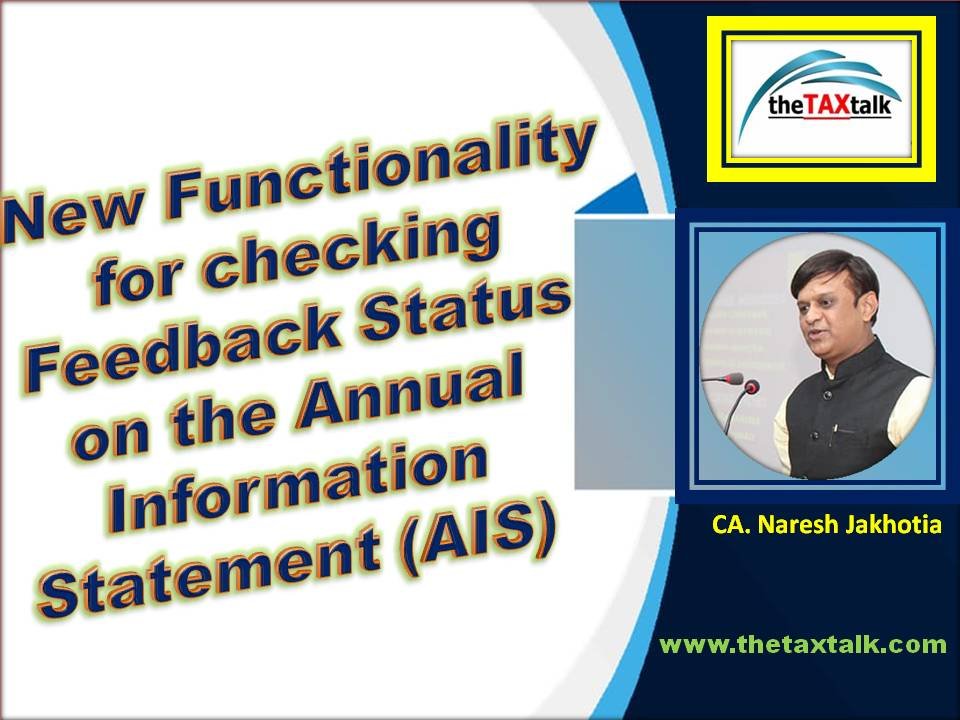![]()
New Functionality for checking Feedback Status on the Annual Information Statement (AIS)
The Income Tax Department is systematically collecting data from a diverse range of agencies and sources to ensure comprehensive tax compliance and enforcement. By leveraging these varied information streams, the department significantly enhances its capabilities to monitor and regulate income tax activities. The key sources of information that contribute to this expansive reach include:
1. Tax Deduction at Source (TDS) to be furnished by the Payer/ Deductor
2. Tax Collection at Source to be furnished by the Seller/Collector.
3. Statement of Financial Transactions (SFT) to be furnished by various reporting entities.
As a result of all above, around 57 types of transactions are getting reported to the income tax department. It may not be wrong at this juncture to say that the income tax department has almost scanned all the high value transactions.
SFT – The Power tool of Information:
The Statement of Financial Transactions (SFT) has emerged as a pivotal instrument for collecting data on significant transactions. The last date for filing SFT by the reporting entities is 31st May. Key transactions reported through SFT include:
1. Reporting by Companies:
All the companies are now required to file SFT if it receives Rs. 10 Lakh or more towards share capital or as share application money. Companies are also required to report receipt from any person of an amount aggregating to Rs. 10 Lakh or more in a financial year for acquiring bonds or debentures issued by it (other than the amount received on account of renewal of the bond or debenture). Further every listed company is required to report buy back of shares from any person (other than the shares bought in the open market) for an amount or value aggregating to Rs. 10 Lakh or more in a financial year.
2. Reporting by Banks:
Banks are required to report –
(a) cash deposits or cash withdrawals (including through bearer’s cheque) aggregating to Rs. 50 Lakh or more in a financial year, in or from one or more current accounts of a person.
(b) One or more time deposits (other than a time deposit made through renewal of another time deposit) of a person aggregating to Rs. 10 Lakh or more in a financial year of a person.
(c) Payment made in cash for purchase of bank drafts or pay orders or banker’s cheque of an amount aggregating to Rs 10 Lakh or more in a financial year
(d) Cash deposits aggregating to Rs. 10 lakh or more in a financial year, in one or more accounts (other than a current account and time deposit) of a person.
3. Credit Card Companies:
Credit card companies are required to report the payments made to it by any person of an amount aggregating to (i) one lakh rupees or more in cash; or (ii) ten lakh rupees or more by any other mode, against bills raised in respect of one or more credit cards issued to that person, in a financial year
4. Immoveable Property Transactions:
Registrar is required to report the transaction of purchase or sale of immovable property for an amount of Rs. 30 Lakh or more or with stamp duty valuation of Rs. 30 Lakh or more.
5. Mutual Funds Houses:
Every Receipt of an amount aggregating to Rs. 10 Lakh or more in a financial year for acquiring units of one or more schemes of a Mutual Fund (other than the amount received on account of transfer from one scheme to another scheme of that Mutual Fund) is required to be reported by every mutual fund house.
5. Other information:
Now, dividend income, capital gain income from sale of shares through stock exchange, interest on SB A/c is also required to be reported by various agencies.
New Functionality in AIS:
1. All the information furnished by the reporting entities gets auto populated in the Annual Information Statement (AIS) of the taxpayers. Taxpayers can access it in the “AIS” option by login at www.incometax.gov.in.
2. There is a functionality to furnish feedback by the taxpayers on every transaction. This feedback helps the taxpayer to comment on the accuracy of the information provided by the Source of such information. In case of wrong reporting, the same is taken up with the Source for their confirmation, in an automated manner.
3. Central Board of Direct Taxes (CBDT) has now rolled out a new functionality in AIS to display the status of information confirmation process. This will display whether the feedback of the taxpayer has been acted upon by the Source, by either, partially or fully accepting or rejecting the same. In case of partial or full acceptance, the information is required to be corrected by filing a correction statement by the Source. The following attributes shall be visible to the taxpayer for status of Feedback confirmation from Source.
i. Whether feedback is shared for confirmation : This will let the taxpayer know if the feedback has been shared with the Reporting Source for confirmation or not.
ii. Feedback Shared On : This will let the taxpayer know the date on which the feedback has been shared with the Reporting Source for confirmation.
iii. Source Responded On : This will let the taxpayer know the date on which the Reporting Source has responded on the feedback shared with it for confirmation.
iv Source Response : This will let the taxpayer know the response provided by the Source on the taxpayer’s feedback (if any correction is required or not).
Conclusion:
The new functionality is expected to increase transparency by displaying such information in AIS to the taxpayer. This is another initiative of the Income Tax Department towards ease of compliance and enhanced taxpayer services.
[Views expressed are the personal view of the author. Readers are advised to seek professional advice before taking any decisions. Readers may forward their feedback & queries at nareshjakhotia@gmail.com. Other articles & response to queries are available at www.theTAXtalk.com]


